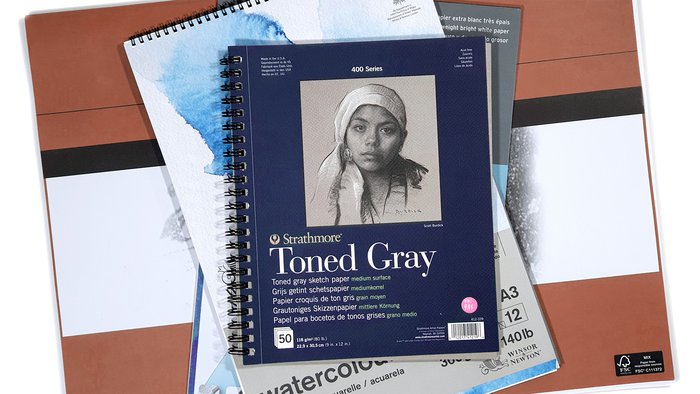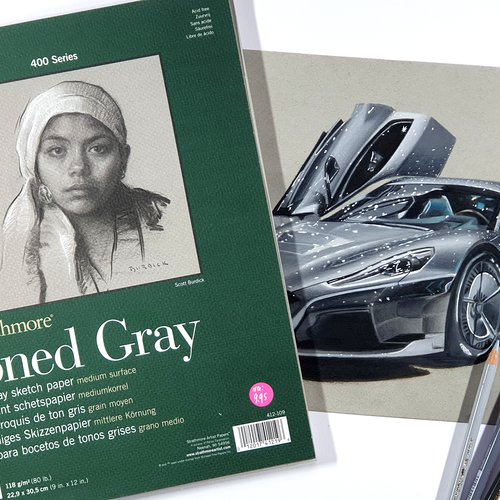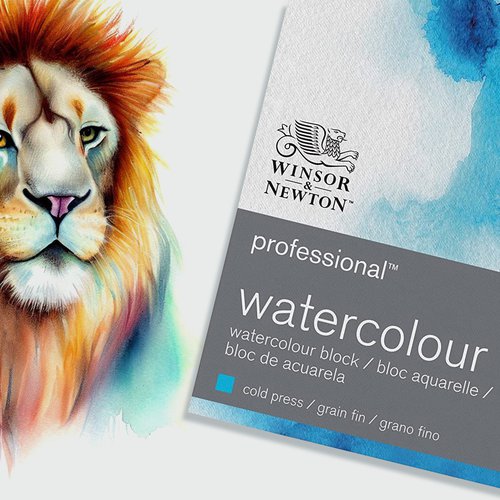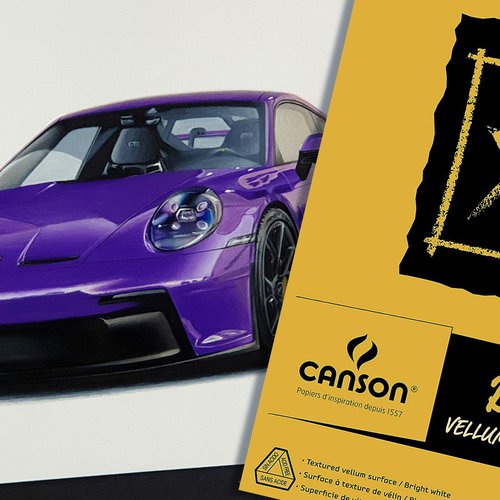How To Choose Colored Pencil Paper - A Complete Guide

Are you a colored pencil artist looking to elevate your artwork to the next level?
Choosing the right paper can make all the difference in the final result of your artwork. With so many options available, it can be overwhelming to choose the right paper for your colored pencil artwork. That's why I've created a full guide to help you choose the right paper for your needs. So let's dive right in!
Want to know what the best paper for colored pencils is? Check out this article on the best brands of paper.
What type of paper should you use?
First off, let's talk about what kind of paper you should be looking for. When it comes to colored pencils, you want paper that has a bit of tooth (texture) to it. This helps the pencil pigment adhere better to the surface and allows for multiple layers of color to be applied without the paper becoming too smooth and waxy.
Now, there are a few different types of paper that are suitable for colored pencils, but they each have their own unique properties. Let's break it down.
- Drawing paper
- Mixed media paper
- Watercolor paper
- Bristol paper
1. Drawing Paper
Drawing paper is a versatile and popular option for colored pencil artists. It's typically a little thicker than printer paper and has a slight tooth or texture to it, which makes it ideal for holding multiple layers of pencil pigment. The texture of the paper allows for the pigment to adhere to the surface without the paper becoming too smooth or waxy.
When choosing drawing paper for colored pencils, consider factors such as weight, texture, and color. Heavier weight paper is more durable and can handle heavier applications of pigment, while a rougher texture can create interesting effects and hold onto the pigment better.
Overall, drawing paper is a versatile and affordable option for colored pencil artists.
2. Mixed-Media Paper
Mixed media paper is a versatile type of paper that is designed to handle a variety of mediums, including colored pencils, watercolors, and markers. It's a popular choice for artists who like to experiment with different mediums or who want to create mixed-media artwork that combines different techniques.
One of the key features of mixed media paper is its texture. It typically has a slightly rough surface that allows for the pigment to adhere to the paper without bleeding or smudging. This texture can vary depending on the type of mixed media paper, so it's important to choose a paper with a texture that suits your style and needs.
Mixed media paper also comes in a variety of weights, ranging from lightweight (90 lb) to heavyweight (140+ lb). The weight of the paper can affect how much pigment it can handle without bleeding or warping, so it's important to choose a weight that can handle the demands of your artwork.
When choosing mixed media paper for colored pencils, it's important to consider the weight, texture, and type of paper. Some mixed media papers have a smoother surface that is ideal for creating crisp lines and precise details, while others have a more textured surface that can create interesting effects and hold onto pigment more effectively.
Overall, mixed-media paper is a great option for artists who like to experiment with different mediums or who want to create mixed-media artwork that combines different techniques. Its versatility and ability to handle multiple mediums make it a popular choice for artists who want to push the boundaries of their creativity.
3. Watercolor Paper
Watercolor paper is a type of paper that is designed specifically for use with watercolor paints, but it can also be a great option for use with watercolor pencils or for creating mixed media artwork with colored pencils and watercolor paints.
One of the key features of watercolor paper is its texture. Watercolor paper typically has a rough or slightly textured surface, which helps the paper to absorb and hold onto watercolor paint more effectively. This texture is also beneficial when using watercolor pencils or when using a solvent to blend your colored pencils, as it allows the pigment to adhere to the paper more easily and can help to prevent the paper from becoming too smooth or waxy.
Watercolor paper also comes in a variety of weights or thicknesses, ranging from lightweight (60 lb) to heavyweight (140+ lb). The weight of the paper can affect how much water the paper can handle without warping or buckling. For colored pencils, medium-weight watercolor paper, around 140 lb, is usually sufficient to handle multiple layers of solvent without warping or buckling.
When choosing watercolor paper for colored pencils, it's important to consider the surface texture, weight, and type of paper. There are three main types of watercolor paper: hot press, cold press, and rough. Hot press paper has a smoother surface texture, while cold press paper has a medium texture and is the most commonly used type of watercolor paper. Rough paper has a very textured surface and is ideal for creating unique effects or for creating textured backgrounds.
Overall, watercolor paper can be a great option for colored pencil artists who want to experiment with mixed media or who prefer a more textured surface for their artwork.
4. Bristol Paper
Bristol paper is a heavyweight, smooth-surfaced paper that is ideal for use with a variety of mediums, including ink, graphite, and colored pencils. It's a popular choice for artists who want to create highly detailed drawings or illustrations and is often used for comic book or manga artwork.
One of the key features of bristol paper is its smooth surface. Unlike other types of paper that have a textured surface, bristol paper has a very smooth surface that allows for sharp, crisp lines and precise details. This makes it ideal for creating intricate drawings or illustrations that require a high level of precision.
Bristol paper also comes in a variety of weights, ranging from lightweight (60 lb) to heavyweight (140+ lb). For colored pencil artists, a medium-weight bristol paper, around 110 lb, is usually sufficient to handle multiple layers of pigment.
When choosing bristol paper for colored pencils, it's important to consider the type of paper. There are two main types of bristol paper: vellum and smooth. Vellum bristol paper has a slightly rougher texture than smooth bristol paper, which can help to hold onto pencil pigment. Smooth bristol paper, on the other hand, has an even smoother surface that is ideal for creating precise details and crisp lines.
Overall, bristol paper is a great option for colored pencil artists who want to create highly detailed, precise artwork. Its smooth surface allows for crisp lines and precise details.
It's important to experiment with different types of paper to find the one that best suits your style and needs.
Now that you know what types of paper are suitable for colored pencils, let's talk about some other factors to consider when choosing paper.
What Paper Weight is Best for Colored Pencils?
The weight of the paper refers to its thickness, which is measured in pounds (lbs) or grams per square meter (gsm). The weight of the paper can affect how much pigment it can handle without tearing, as well as how durable and sturdy it is.
For colored pencil artwork, it's important to choose a paperweight that can handle multiple layers of pencil pigment. Generally, heavier-weight paper is more durable and can handle heavier applications of pigment, while lighter-weight paper may be more affordable but may not hold up as well to multiple layers of pencil pigment.
Here are some common paper weights for colored pencil artwork:
Lightweight paper: 50-80 lb (75-130 gsm) - Lightweight paper is thin and affordable, but it may not hold up well to multiple layers of pigment and can be prone to tearing or bleeding.
Medium-weight paper: 90-110 lb (180-250 gsm) - Medium-weight paper is a popular choice for colored pencil artists, as it can handle multiple layers of pigment without tearing or damaging the paper. It's also sturdy enough to withstand erasing and blending.
Heavyweight paper: 140+ lb (300+ gsm) - Heavyweight paper is the most durable and sturdy option, but it can also be the most expensive. It can handle the heaviest applications of pigment and is ideal for highly detailed, complex artwork. It also barely warps when using solvents or water to blend your colored pencils.
What Paper Texture is Best for Colored Pencils?
The texture of the paper refers to the surface of the paper and how rough or smooth it is. The texture of the paper can affect how the pigment adheres to the paper and how easy or difficult it is to layer or blend colors.
When it comes to colored pencil artwork, the texture of the paper is an important consideration. Paper with too smooth of a texture can make it difficult to layer or blend colors, while paper with too rough of a texture can cause the pigment to become too textured or grainy. It's important to choose a paper texture that suits your style and needs.
Here are some common paper textures for colored pencil artwork:
Smooth: Smooth paper has a very fine texture that allows for precise details and crisp lines. It's ideal for highly detailed work or for artwork that requires sharp, defined edges. Smooth paper might not be the best choice if you have hard oil-based colored pencils as these pencils don't give off their pigment very easily. A more textured paper might be a better option.
Medium: Medium paper has a slightly rougher texture that allows for some layering and blending of colors. It can create interesting effects and adds a subtle texture to the artwork.
Rough: Rough paper has a very textured surface that can create unique effects and add a lot of texture to the artwork. It can be more difficult to layer and blend colors on rough paper, but it can be a great option for creating textured backgrounds or adding a unique touch to your artwork.
It's important to note that the texture of the paper can vary within each category. Some smooth papers may be extremely smooth, while others may have a slightly more textured surface. The same is true for medium and rough papers.
What Paper Color is Best for Colored Pencils?
The color of the paper can affect the final look of your artwork and can be an important consideration when choosing paper for colored pencils. While white is the most commonly used color for paper, there are other colors available that can add a unique touch to your artwork.
Here are some common paper colors for colored pencil artwork:
White: White paper is the most commonly used color for colored pencil artwork. It allows the true colors of the pencils to show through and creates a bright, clean look to the artwork.
Cream: Cream-colored paper is a popular alternative to white paper. It can create a warmer, softer look to the artwork and can complement earthy or muted colors.
Gray: Gray-colored paper can create interesting contrasts and shadows in the artwork. It can also make brighter colors pop and create a unique, monochromatic look to the artwork.
Black: Black-colored paper can create dramatic contrasts and add a moody, mysterious tone to the artwork. It can be a great option for creating high-contrast artwork or for adding a unique touch to your artwork.
It's important to note that the color of the paper can affect how the colors of the pencils appear. For example, using bright colors on a cream-colored paper may create a softer, muted look to the artwork, while using the same colors on a white paper may create a brighter, more vibrant look.
When choosing paper for colored pencils, it's important to consider the color of the paper and how it will affect the final look of your artwork. It's always a good idea to experiment with different colors to see what works best for your style and needs.





Be the first to comment!
Comments
There are no comments yet.